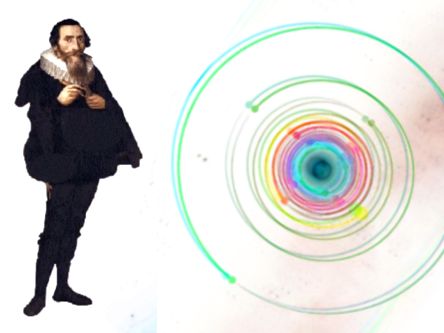Pythagoras to Plato, Philolaus, Cicero, Ptolemy, Boethius, Robert Fludd and many other scholars used different metaphysical or aesthetic arguments to associate to each celestial body a pitch, according to the best musical theory of his time.
However, it was Kepler, who proceeded on a firm logical and quantitative basis, by means of his Third Planetary Law.
But how did our wandering mathematician come to discover the ‘harmony of the world’?

It is said that the Music of the Spheres was first realised by Pythagoras with his interpretation of the monochord. He is said to have determined the numerical ratios corresponding to the musical concordances:
- A half for the octave
- Two thirds for the fifth
- And three quarters for the fouth
Then, ancient Greek philosophers compared the cosmos to the musicals scale. The sun is essential correspondence to the since it corresponds to the central note that links two tetra chords.
According to Ptolemy the perfect harmony of the heavens is reflected in the 3 consonances internal to the circle of the zodiac. in which the musical proportions derive from the rations between the arcs subtended by the diameter corresponding to the octave. The sides of a triangle, corresponding to a fifth, and the sides of a square corresponding to the fourth.
Man himself is enclosed within the circumference where the harmony of the planets, the seasons and the song of the muses act on both the external microcosm and the internal one.
Then came Kepler. Realising the orbits of the planets were elliptical and not circular, he attributes to the not a single sound to each planet but an interval. In this interpretation, the lowest note corresponds to the planets minimum velocity and the highest to its maximum.
The staves represent the harmonic structure of the cosmos acoustically. The amplitude fo the intervals is directly proportional to the eccentricity of the planets.
Later, in medieval times the biblical passages “the heavens shall sing the glory of God”
God is at the same time a supreme geometer and a perfect musician.
Discover how the harmony of the spheres became the unifying principle of reality…
First: A brief history of the Music of the Spheres / Harmony of the Worlds. Narrated by Michel Nabti.
Johannes Kepler’s 1619 treatise realized by a computer music group at Princeton
Kepler’s Music interpreted by Paolo Maraner and read by Elena Acinapura
Giovanni Keplero – Harmonices Mundi – Musica di Keplero sull’ armonia delle sfere.
Kepler’s Music of the Spheres from SpaceSounds – National Geographic: Our Universe flexidisc.
The first 16 notes of the musical harmonic series are played by a hypothetical planetary system.
And we finish with the quite remarkable interpretation by Fiona Millward and Jo Fairfax
No Comment
You can post first response comment.